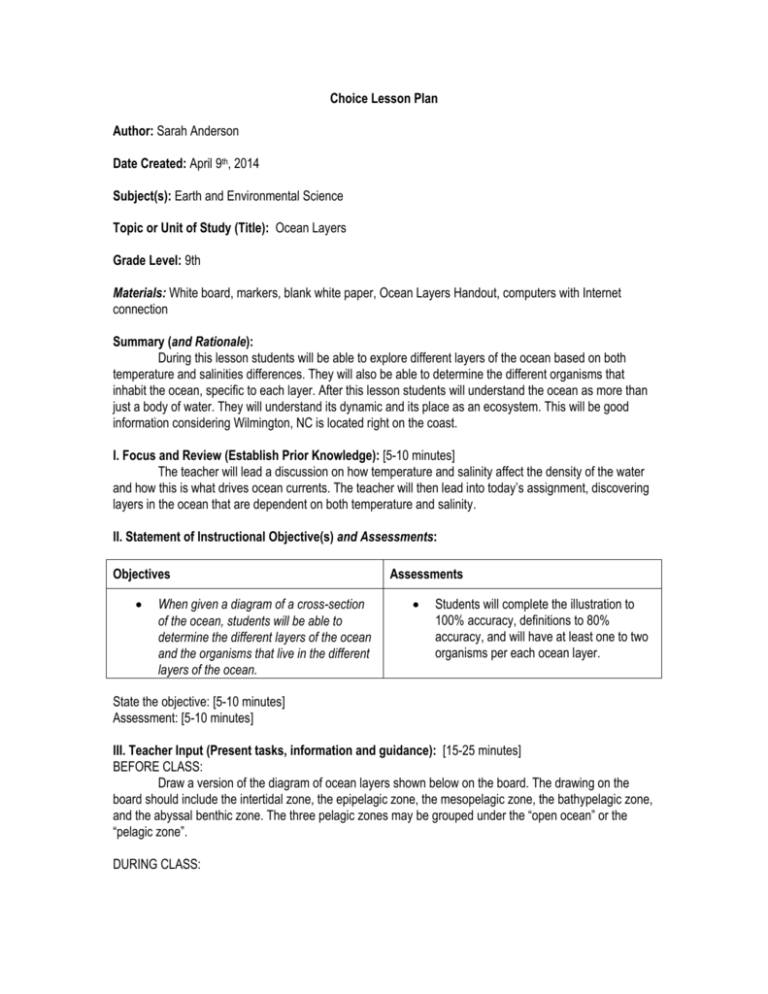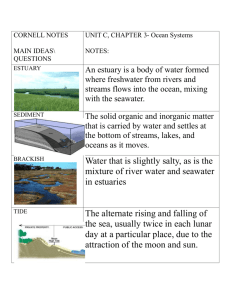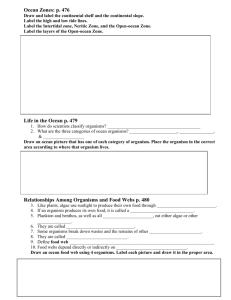File - Sarah V Anderson
advertisement

Choice Lesson Plan Author: Sarah Anderson Date Created: April 9th, 2014 Subject(s): Earth and Environmental Science Topic or Unit of Study (Title): Ocean Layers Grade Level: 9th Materials: White board, markers, blank white paper, Ocean Layers Handout, computers with Internet connection Summary (and Rationale): During this lesson students will be able to explore different layers of the ocean based on both temperature and salinities differences. They will also be able to determine the different organisms that inhabit the ocean, specific to each layer. After this lesson students will understand the ocean as more than just a body of water. They will understand its dynamic and its place as an ecosystem. This will be good information considering Wilmington, NC is located right on the coast. I. Focus and Review (Establish Prior Knowledge): [5-10 minutes] The teacher will lead a discussion on how temperature and salinity affect the density of the water and how this is what drives ocean currents. The teacher will then lead into today’s assignment, discovering layers in the ocean that are dependent on both temperature and salinity. II. Statement of Instructional Objective(s) and Assessments: Objectives When given a diagram of a cross-section of the ocean, students will be able to determine the different layers of the ocean and the organisms that live in the different layers of the ocean. Assessments Students will complete the illustration to 100% accuracy, definitions to 80% accuracy, and will have at least one to two organisms per each ocean layer. State the objective: [5-10 minutes] Assessment: [5-10 minutes] III. Teacher Input (Present tasks, information and guidance): [15-25 minutes] BEFORE CLASS: Draw a version of the diagram of ocean layers shown below on the board. The drawing on the board should include the intertidal zone, the epipelagic zone, the mesopelagic zone, the bathypelagic zone, and the abyssal benthic zone. The three pelagic zones may be grouped under the “open ocean” or the “pelagic zone”. DURING CLASS: Explain to the class that the diagram shows different depths of the ocean. The intertidal zone is the region along the shoreline covered by the sea at high tide and exposed to air at low tide. The epipelagic zone is the upper pelagic zone of the open ocean. The zonation is based on the daytime distribution of animals. The depth of the zones depends on water clarity, which varies between regions. The mesopelagic zone is the middle pelagic zone of the open ocean. The bathypelagic zone is the deep pelagic zone of the open ocean. It is the zone beneath the mesopelagic zone. IV. Guided Practice (Elicit performance): [40-50 minutes] Give each student a copy of the ocean layers handout. Have the students illustrate this diagram on a sheet of blank paper independently. As the students are drawing the diagram on their own paper walk around the classroom to make sure each student understands the layers of the ocean. After they complete the drawing have them write the definitions of each zone that was discussed on the board on the back of the paper, including neritic, oceanic, benthic, pelagic, continental shelf, and continental slope. When the students have completed the illustration and the definitions arrange them into groups. Each group should research different organisms, using the computer with internet access, that live in each of the zones that were discussed on the board (intertidal, the three pelagic zones, and the abyssal benthic zone). There should be at least three organisms for each layer. V. Closure (Plan for maintenance): [10 minutes] When the students have finished researching each of the layer inhabitants come together as a class and discuss what each group found. Discuss any similarities between the organisms that live in the same layer and any differences between organisms that live in different layers. VI. Independent Practice: If there is not enough time for the students to finish researching the different organisms that are located in the ocean layers have the finish this independently for homework. If they were able to finish the research have each student pick one layer and write a short report on the characteristics of this layer and the organisms that dwell in it. STANDARDS: EEn.2.3 – Explain the structure and process within the hydrosphere EEn.2.3.2 – Explain how water is an energy agent (currents and heat transfer) HS.SI.1 - Evaluate resources needed to solve a given problem. HS.SI.1.3 - Evaluate content for relevance to the assigned task. Plans for Individual Differences: During the guided practice the teacher will be walking around to make sure that anyone who doesn’t understand the different layers will be able to ask any questions before creating groups. In the group work each student will be able to play to his or her individual strengths. At the end of the class, the group discussion will allow for any other unexplained questions. References (APA style): Milani, V. (2013). Ocean zones and layers . Retrieved from http://b2science.org/sites/b2science.org/files/taraplan10.pdf






